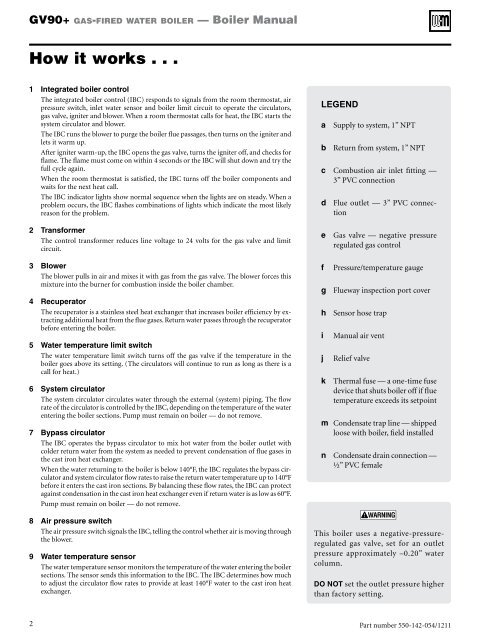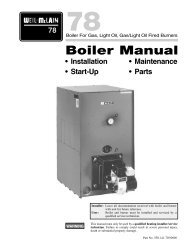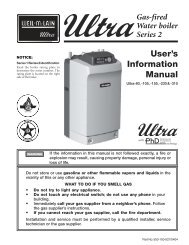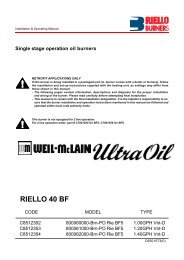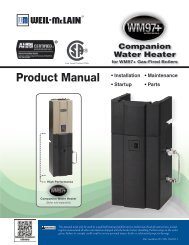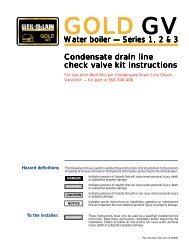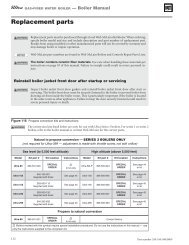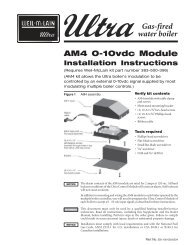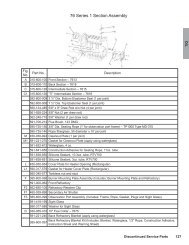Boiler Manual - Weil-McLain
Boiler Manual - Weil-McLain
Boiler Manual - Weil-McLain
You also want an ePaper? Increase the reach of your titles
YUMPU automatically turns print PDFs into web optimized ePapers that Google loves.
GV90+ gas-fired water boiler — <strong>Boiler</strong> <strong>Manual</strong>How it works . . .1 Integrated boiler controlThe integrated boiler control (IBC) responds to signals from the room thermostat, airpressure switch, inlet water sensor and boiler limit circuit to operate the circulators,gas valve, igniter and blower. When a room thermostat calls for heat, the IBC starts thesystem circulator and blower.The IBC runs the blower to purge the boiler flue passages, then turns on the igniter andlets it warm up.After igniter warm-up, the IBC opens the gas valve, turns the igniter off, and checks forflame. The flame must come on within 4 seconds or the IBC will shut down and try thefull cycle again.When the room thermostat is satisfied, the IBC turns off the boiler components andwaits for the next heat call.The IBC indicator lights show normal sequence when the lights are on steady. When aproblem occurs, the IBC flashes combinations of lights which indicate the most likelyreason for the problem.2 TransformerThe control transformer reduces line voltage to 24 volts for the gas valve and limitcircuit.3 BlowerThe blower pulls in air and mixes it with gas from the gas valve. The blower forces thismixture into the burner for combustion inside the boiler chamber.4 RecuperatorThe recuperator is a stainless steel heat exchanger that increases boiler efficiency by extractingadditional heat from the flue gases. Return water passes through the recuperatorbefore entering the boiler.5 Water temperature limit switchThe water temperature limit switch turns off the gas valve if the temperature in theboiler goes above its setting. (The circulators will continue to run as long as there is acall for heat.)6 System circulatorThe system circulator circulates water through the external (system) piping. The flowrate of the circulator is controlled by the IBC, depending on the temperature of the waterentering the boiler sections. Pump must remain on boiler — do not remove.7 Bypass circulatorThe IBC operates the bypass circulator to mix hot water from the boiler outlet withcolder return water from the system as needed to prevent condensation of flue gases inthe cast iron heat exchanger.When the water returning to the boiler is below 140°F, the IBC regulates the bypass circulatorand system circulator flow rates to raise the return water temperature up to 140°Fbefore it enters the cast iron sections. By balancing these flow rates, the IBC can protectagainst condensation in the cast iron heat exchanger even if return water is as low as 60°F.Pump must remain on boiler — do not remove.8 Air pressure switchThe air pressure switch signals the IBC, telling the control whether air is moving throughthe blower.9 Water temperature sensorThe water temperature sensor monitors the temperature of the water entering the boilersections. The sensor sends this information to the IBC. The IBC determines how muchto adjust the circulator flow rates to provide at least 140°F water to the cast iron heatexchanger.LEGENDa Supply to system, 1” NPTb Return from system, 1” NPTc Combustion air inlet fitting —3” PVC connectiond Flue outlet — 3” PVC connectione Gas valve — negative pressureregulated gas controlfPressure/temperature gaugeg Flueway inspection port coverh Sensor hose trapij<strong>Manual</strong> air ventRelief valvek Thermal fuse — a one-time fusedevice that shuts boiler off if fluetemperature exceeds its setpointm Condensate trap line — shippedloose with boiler, field installedn Condensate drain connection —½” PVC femaleThis boiler uses a negative-pressureregulatedgas valve, set for an outletpressure approximately –0.20” watercolumn.DO NOT set the outlet pressure higherthan factory setting.2Part number 550-142-054/1211


